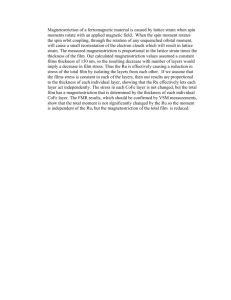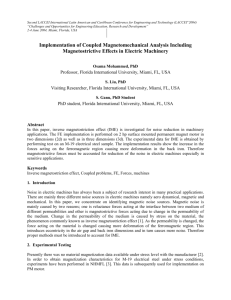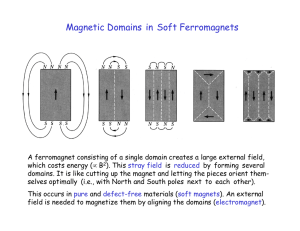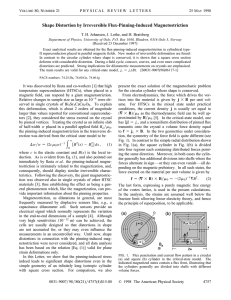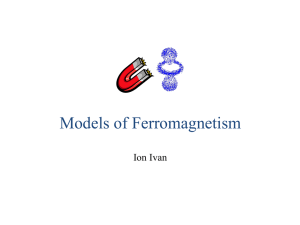Influence of the real shape of a sample on the... induced magnetostriction
advertisement
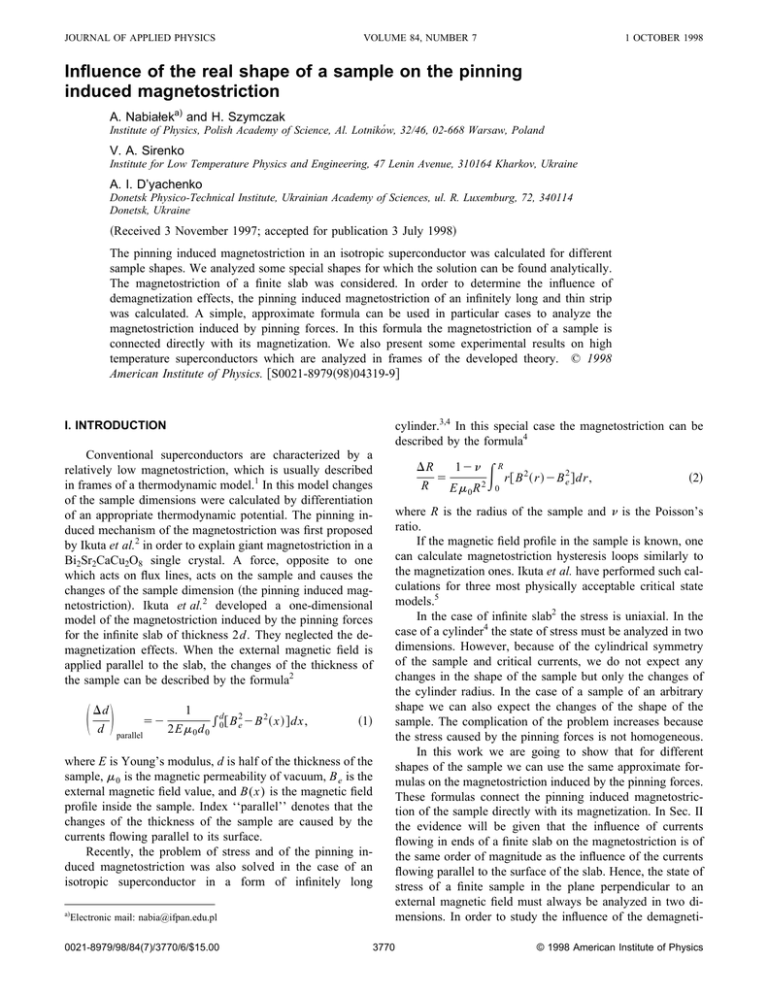
JOURNAL OF APPLIED PHYSICS VOLUME 84, NUMBER 7 1 OCTOBER 1998 Influence of the real shape of a sample on the pinning induced magnetostriction A. Nabiałeka) and H. Szymczak Institute of Physics, Polish Academy of Science, Al. Lotników, 32/46, 02-668 Warsaw, Poland V. A. Sirenko Institute for Low Temperature Physics and Engineering, 47 Lenin Avenue, 310164 Kharkov, Ukraine A. I. D’yachenko Donetsk Physico-Technical Institute, Ukrainian Academy of Sciences, ul. R. Luxemburg, 72, 340114 Donetsk, Ukraine ~Received 3 November 1997; accepted for publication 3 July 1998! The pinning induced magnetostriction in an isotropic superconductor was calculated for different sample shapes. We analyzed some special shapes for which the solution can be found analytically. The magnetostriction of a finite slab was considered. In order to determine the influence of demagnetization effects, the pinning induced magnetostriction of an infinitely long and thin strip was calculated. A simple, approximate formula can be used in particular cases to analyze the magnetostriction induced by pinning forces. In this formula the magnetostriction of a sample is connected directly with its magnetization. We also present some experimental results on high temperature superconductors which are analyzed in frames of the developed theory. © 1998 American Institute of Physics. @S0021-8979~98!04319-9# cylinder.3,4 In this special case the magnetostriction can be described by the formula4 I. INTRODUCTION Conventional superconductors are characterized by a relatively low magnetostriction, which is usually described in frames of a thermodynamic model.1 In this model changes of the sample dimensions were calculated by differentiation of an appropriate thermodynamic potential. The pinning induced mechanism of the magnetostriction was first proposed by Ikuta et al.2 in order to explain giant magnetostriction in a Bi2Sr2CaCu2O8 single crystal. A force, opposite to one which acts on flux lines, acts on the sample and causes the changes of the sample dimension ~the pinning induced magnetostriction!. Ikuta et al.2 developed a one-dimensional model of the magnetostriction induced by the pinning forces for the infinite slab of thickness 2d. They neglected the demagnetization effects. When the external magnetic field is applied parallel to the slab, the changes of the thickness of the sample can be described by the formula2 S D Dd d 52 parallel 1 * d @ B 2 2B 2 ~ x !# dx, 2E m 0 d 0 0 e 12 n DR 5 R E m 0R 2 R 0 r @ B 2 ~ r ! 2B 2e # dr, ~2! where R is the radius of the sample and n is the Poisson’s ratio. If the magnetic field profile in the sample is known, one can calculate magnetostriction hysteresis loops similarly to the magnetization ones. Ikuta et al. have performed such calculations for three most physically acceptable critical state models.5 In the case of infinite slab2 the stress is uniaxial. In the case of a cylinder4 the state of stress must be analyzed in two dimensions. However, because of the cylindrical symmetry of the sample and critical currents, we do not expect any changes in the shape of the sample but only the changes of the cylinder radius. In the case of a sample of an arbitrary shape we can also expect the changes of the shape of the sample. The complication of the problem increases because the stress caused by the pinning forces is not homogeneous. In this work we are going to show that for different shapes of the sample we can use the same approximate formulas on the magnetostriction induced by the pinning forces. These formulas connect the pinning induced magnetostriction of the sample directly with its magnetization. In Sec. II the evidence will be given that the influence of currents flowing in ends of a finite slab on the magnetostriction is of the same order of magnitude as the influence of the currents flowing parallel to the surface of the slab. Hence, the state of stress of a finite sample in the plane perpendicular to an external magnetic field must always be analyzed in two dimensions. In order to study the influence of the demagneti- ~1! where E is Young’s modulus, d is half of the thickness of the sample, m 0 is the magnetic permeability of vacuum, B e is the external magnetic field value, and B(x) is the magnetic field profile inside the sample. Index ‘‘parallel’’ denotes that the changes of the thickness of the sample are caused by the currents flowing parallel to its surface. Recently, the problem of stress and of the pinning induced magnetostriction was also solved in the case of an isotropic superconductor in a form of infinitely long a! Electronic mail: nabia@ifpan.edu.pl 0021-8979/98/84(7)/3770/6/$15.00 E 3770 © 1998 American Institute of Physics Nabiałek et al. J. Appl. Phys., Vol. 84, No. 7, 1 October 1998 3771 zation effects, we will consider ~in Sec. III! a model of a critical state of an infinitely long and thin strip with magnetic field applied perpendicularly to the surface of the strip; it means the sample with an extremely large demagnetization factor. The currents’ and magnetic field’s distribution in this model was recently found analytically by Brandt et al.6 We will consider only the model with the isotropic critical current density in the plane perpendicular to external magnetic field. This approximation seems to be reasonable for high temperature superconductors ~HTSs! also, when we measure a transverse magnetostriction ~the changes of the dimension of the sample are measured perpendicularly to the external magnetic field! and magnetic field is oriented parallel to the c axis ~it means that the shielding currents flow in the ab plane! of the layered HTS. In Sec. IV, some experimental results on HTSs will be presented. These results confirm the main conclusions following theoretical considerations. II. INFLUENCE OF CURRENTS FLOWING IN THE ENDS OF A FINITE SLAB Following Refs. 2 and 5 we will consider only the pinning induced part of magnetostriction. We will neglect the reversible part of magnetostriction connected with the Meissner shielding currents on the surface of the sample. In HTSs the values of the first critical field are low and a reversible part of the magnetostriction is negligible. The reversible part of the magnetostriction can be easily calculated. This was done by Brändli.1 In his work1 an analysis of experimental data of the reversible part of the magnetostriction for conventional superconductors was also performed. In some superconductors we can observe large magnetostriction caused by the presence of magnetic rare-earth ions.7 Since the mechanism of this part of the magnetostriction is completely different, we will not discuss it in the present work. At this point, we would like to make a short comparison between the model of the magnetostriction proposed by Ikuta et al.2 and that developed by Brändli.1 The magnetic induction profile inside a sample determines the pinning induced magnetostriction. Instead of talking about pinning forces as the cause of the magnetostriction in the superconductor ~like in the work of Ref. 2!, we can talk about the pressure of the magnetic field ~similarly like in the work of Ref. 1!. Such pressure acts on every sample with nonzero magnetization in an external magnetic field. In his work1 Brändli calculated the magnetostriction of superconductors as a consequence of magnetic field pressure, which acts on the surface of the sample. In his experiments on conventional superconductors the irreversible part of magnetostriction was small in comparison to the reversible one. What makes type-II superconductors different from other magnetics is the fact that magnetic induction inside the superconductor changes according to the critical state condition. In this case it is not enough to consider the magnetic field pressure on the sample surface ~like in the work of Ref. 1! but we have also to remember about magnetic forces, which act on the whole volume of the sample. These forces are equivalent to the pinning forces. In this section we will consider a slab, in which the cross section in the plane perpendicular to an external magnetic field is presented in Fig. 1~a!. At first we assume the length FIG. 1. The cross section of a finite slab in the plane perpendicular to an external magnetic field. ~a! The sample is divided into a central part in form of a parallelepiped and two ends in the form of halves of a cylinder; the flow of screening currents is also shown. ~b! The influence of the ends of the finite slab is equivalent two opposite forces, which act on the central part of the finite slab. ~c! The integration of the y component of the pinning forces over the end of a finite slab. of the sample in the direction perpendicular to an external magnetic field to be large in comparison to the thickness of the sample—2d. The length of the sample parallel to an external magnetic field is infinite. It means that similarly as in the works of Ref. 2–5 we can neglect the demagnetization effects. We can divide this sample into three parts @as is shown in Fig. 2~a!#: the central part, whose cross section is in form of a rectangle with dimensions 2d3L and two ends of the sample in form of two halves of the cylinder. In the central part of the sample, currents are flowing only parallel to the surface of the slab. These currents induce in the central part of the sample the uniaxial stress. This state of stress we can consider in frames of the model proposed by Ikuta et al.2 We have assumed the ends of the slab to be relatively small in comparison to the central part. Hence, we will study only the influence of the ends on the central part of the slab and we will neglect the deformation of the ends. Bearing in mind the above discussion, one can consider the influence of the ends as two opposite forces F y and -F y . These forces are applied to the sample @as is shown in Fig. 1~b!# and cause an uniaxial and homogeneous stress with s y 5F y /2dh, where h→` is the length of the slab parallel to an external magnetic field. In this case the changes of the length L of the sample, caused by the forces 6F y , will be described by a simple formula: S D DL L 5 Fy sy . E ~3! Index ‘‘F y ’’ denotes that the changes of the slab length are 3772 Nabiałek et al. J. Appl. Phys., Vol. 84, No. 7, 1 October 1998 currents flowing parallel to its surface.2,5 In this case the relative changes of the thickness of the finite slab are given by the formula (Dd/d) total5(Dd/d) parallel2 n (DL/L) F y . The relative changes of the length of the sample are given by the approximate formula (DL/L) total'(DL/L) F y 2 n (Dd/d) parallel . Using these formulas as well as Eqs. ~1! and ~5! we obtain finally S D Dd d FIG. 2. The irreversible part of the transverse ~a,c,e! and longitudinal ~b,d,f! magnetostriction of ceramics YBa2Cu3O72d measured at 4.2 ~a,b!, 20 ~c,d!, and 40 K ~e,f!. Dotted lines show the fitting curves. caused by forces 6F y . In order to calculate the F y force, we integrate the y component of the pinning forces over the ends of the sample @as it is shown in Fig. 1~c!#. F y 5h E p 0 sin w d w E d 0 J c ~ x ! B ~ x ! xdx, ~4! where * p0 sin w dw52 and J c (x) is the critical current distribution given by the critical state condition J c ~ x ! 52 1 dB ~ x ! . m 0 dx On the basis of Eqs. ~3! and ~4! we finally obtain S D DL L 52 Fy 1 2E m 0 d E d 0 @ B 2e 2B 2 ~ x !# dx. ~5! The relative changes of the length of the finite slab caused by its ends ~5! are exactly the same as the relative changes of the thickness of the slab caused by the currents flowing parallel to its surface ~1!. According to the Poisson’s rule, in the case of uniaxial and homogeneous stress, the changes of the length (DL/L) F y cause the changes of the thickness 2d @ (Dd/d) F y 52 n (DL/L) F y # . The currents flowing parallel to the surface of the slab will also ~according to the Poisson’s rule! cause the changes of its length (DL/L) parallel . Unfortunately, the stress induced by these currents is not homogeneous and the formula @ (DL/L) parallel5 2 n (Dd/d) parallel# can be used only as an approximation. We will further consider the state of stress in the fininte slab as a superposition of the uniaxial homogeneous stress caused by the ends of the slab and the state of stress induced by the 52 total 12 n 2E m 0 d 0 E d 0 @ B 2e 2B 2 ~ x !# dx' S D DL L . total ~6! The only difference between the formula on the magnetostriction of an infinite slab ~1! and a finite slab ~6! is a coefficient of (12 n ). However, even for a very long ~but finite! slab the state of stress is two dimensional and we cannot neglect the influence of the ends of the sample on the total magnetostriction. When an external magnetic field is swept between two extreme values 2B m and B m a hysteresis loop of the magnetostriction is observed. Applying an original Bean model ~it means, assuming that J c is independent on a magnetic field!, one can obtain the formula on the width of the magnetostriction hysteresis loop. In the range 2B m 12B p ,B e ,B m 22B p ~where B p is the field of full penetration; B p 5 m 0 J c a; a5d for a slab or a5R for a cylinder! it was found:4,5 D S D Dd Dd Dd 12 n 5 J B d 5 2 d d↓ d↑ E c e ~7! in the case of finite slab and D S D S D DR DR DR 2 12 n 2 5 5 J cB eR R R↓ R↑ 3 E ~8! in the case of a cylinder. The arrows ↓↑ denote a decreasing and an increasing magnetic field, respectively. Bearing in mind the formulas on the widths of the magnetization hysteresis loops DM 5M ↓ 2M ↑ 5J c d in the case of slab and DM 5(2/3)J c R in the case of a cylinder and Eqs. ~7! and ~8!, it is easy to find a formula, which is valid both for a cylinder and for a finite slab. This formula connects directly the width of the transverse magnetostriction hysteresis loop and the magnetization hysteresis loop: D S D Dd d 5 transverse S D 12 n B e DM . E ~9! In some experiments, we measure also the longitudinal magnetostriction. It means, the changes of the sample dimensions are measured parallel to the direction of an external magnetic field. According to our approximation, the state of stress of a finite slab in the plane perpendicular to an external magnetic field can be treated as symmetric similarly as in the case of a cylinder, because (Dd/d) total'(DL/L) total @see formula ~6!#. In the case of homogeneous and symmetric stress in the plane perpendicular to an external magnetic field the longitudinal magnetostriction is connected with the transverse one by the formula Nabiałek et al. J. Appl. Phys., Vol. 84, No. 7, 1 October 1998 D S D Dh h FS D 522 n D longitudinal Da a transverse G . ~10! However, as the stress induced by the pinning forces is in general not homogeneous, this formula should be treated only approximately. According to our assumptions the formula ~9! is valid only for two extreme cases ~a cylinder and a very long slab!. Until now in our considerations we have neglected the deformation of the ends of a finite slab assuming the length L of the slab to be large in comparison to its diameter 2d. However, we have assumed the ends of the slab in form of two halves of a cylinder. It seems reasonable to treat approximately the deformation of such two halves of the cylinder ~connected by a central part in the form of a finite slab! as a deformation of a cylinder. In this case formula ~9! can also be used ~approximately! even in the case d'L. The generalization of the formula ~9! on the sample of an arbitrary shape can be done only approximately and for some special shapes of the sample. The exact solution of the problem of the state of stress of the sample with an arbitrary shape is not easy. In most cases numerical calculations are necessary. However, in our opinion, formula ~9! can be used as a relatively good approximation for a wide class of samples studied in experiments. The currents’ distribution in samples with extremely large demagnetization factors ~it means in strips and disks! has been studied by many authors.6,8 We have chosen the model proposed by Brandt et al.,6 because in this model the currents’ and magnetic field’s distributions in the superconductor can be expressed by relatively simple analytical formulas. In this model we consider a strip with the width 2a ~along the y axis! and the thickness d ~along the x axis! assuming the sample to be infinitely long ~along z axis!. We assume the current to be constant over the whole thickness of the strip and J c to be independent on a magnetic field, similarly as in the Bean model. An external magnetic field is applied along the x axis perpendicularly to the surface of a strip. For simplicity we will consider only the zero field cooling (ZFC) magnetostriction curve (the magnetostriction is measured after cooling the sample in zero external magnetic field). In order to simplify the calculation, let us introduce some new relative variables and parameters: h 5y/a; h 5B e /B * where B * 5 m 0 J c d, k51/cosh(ph), c5 A12k 2 5tanh(ph). According to Ref. 6 the current distribution in the sample is given by the following formulas: J z~ h ! 5 2J c arctan p J z ~ h ! 5J c for III. MAGNETOSTRICTION OF AN INFINITELY LONG AND THIN STRIP In this section, we will try to answer the question—how do the demagnetization effects influence the pinning induced magnetostriction in the superconductor. The simplest way to consider demagnetization effects in magnetic materials is the introduction of demagnetization factor. Such approximation in the case of the pinning induced magnetostriction was also suggested by Ikuta et al.2 The simple introduction of a demagnetization factor in case of superconductors is not fully appropriate. This is mainly because the magnetization of the superconductor is caused by macroscopic screening currents. The self component of the magnetic field could change radically the distribution of currents in the sample. Below, we will consider a sample with extremely large demagnetization factor. We will study an infinitely long and thin strip with an external magnetic field applied perpendicular to the surface of the strip. The aim of our considerations is to show an example of analytical solution of the influence of demagnetization effects on the magnetostriction induced by the pinning forces. However, if one analyzes the magnetostriction of a real superconducting sample, whose shape is similar to a thin strip, some additional factors should be taken into account. In our consideration we have neglected the effect of buckling. This effect plays an important role in the case of thin strip, when the forces act parallel to its surface. The most common samples, whose shapes are similar to the thin strips, are thin films. Thin films, however, are deposited on a substrate. In this case the interaction between the film and the substrate plays an important role. We do not consider this interaction in our model. 3773 S ch Ak 2 2h2 D for 0, h ,k, ~11! k, h ,1. The distribution of the x component of a magnetic field in the sample is given by H x ~ h ! 50 for H x~ h ! 5 0, h ,k, J cd arctanh p SA D h 2 2k 2 ch ~12! for k, h ,1. The y component of the pinning force per unit volume is f y ( h )5J z ( h )B x ( h )5 m 0 J z ( h )H x ( h ). The y component of an internal local stress one can obtain by integrating s y ( h ) 5a * f y ( h )d h 1C. The constant C was obtained from the boundary condition s y (1)50. Finally, the following stress distribution is found: s y~ h !5 m 0 J 2c ad ln~ k ! for p 0, h ,k, ~13! m 0 J 2c ad s y~ h !5 @ I ~ k, h ! 1ln~ k !# for p where I ~ k, h ! 5 h arctanh SA D k, h ,1, S D Ah 2 2k 2 h 2 2k 2 2arctanh . ch c In order to obtain the relative changes of the width of the strip we should integrate « y 5 s y /E over the whole width of the strip, which means Da 1 5 a E Es a 0 y~ h !d h . ~14! From Eqs. ~13! and ~14! it was found: S D 1 Da Be 52 J c aB e tanh p . a 2E B* ~15! 3774 Nabiałek et al. J. Appl. Phys., Vol. 84, No. 7, 1 October 1998 On the other hand, the magnetization in Brandt et al.6 model is given ~for ZFC curve! by the simple formula: S D 1 Be M 52 J c a tanh p . 2 B* ~16! Hence, by comparison of Eqs. ~15! and ~16! the magnetostriction of an infinitely long and thin strip could be connected with its magnetization by a very simple formula: Da 1 5 M Be . a E ~17! According to formula ~17! the magnetostriction of a strip is proportional to the product of its magnetization and an external magnetic field. Hence we expect the influence of demagnetization effects on the pinning induced magnetostriction in the superconductor to be the same ~at least in the case of the strip! as on its magnetization. For an external magnetic field B e !B * 5 m 0 J c d ~where d is the thickness of the strip! tanh(pBe /B*)'pBe /B* and Da/a'2(1/2E)(B 2e / m 0 ) 3( p a/d). In this range the pinning induced magnetostriction of a strip is higher than the magnetostriction of an infinite slab5 by a factor of ( p a/d). When an external magnetic field B e @B * , Da/a'2(1/2E)J c aB e . In this case we have a linear dependence of the magnetostriction with the same coefficient as for an infinite slab.5 Similarly as in the case of an infinite slab,2,5 we have assumed our strip to be infinitely long. However, as we have proved in Sec. II, even for a very long but finite slab we expect the influence of the currents flowing in its ends on the magnetostriction to be the same order of magnitude as the influence of the currents flowing parallel to the surface of the slab. It seems to be reasonable to expect a similar effect in the case of the strip with finite length also. Hence we presume that in the Eqs. ~15! and ~17! a coefficient of (12 n ) should appear in the case of a strip with finite length. In this case the formula ~9!, which correlates the widths of the magnetostriction and magnetization hysteresis loops in case of a cylinder and a finite slab, should also be valid in the case of a strip with finite length. At this point one can see an additional convenience of application of the approximate formula ~9! in the analysis of the experimental results of the pinning induced magnetostriction, as in this formula the influence of demagnetization effects is also included. IV. COMPARISON WITH THE EXPERIMENTS ON HTSs In this section we are going to discuss the applications of the isotropic theory based on the pinning induced mechanism of the magnetostriction in the analysis of the experimental results on HTSs. We have investigated the magnetostriction in HTSs by the strain gauge technique. The measurements were performed below T c in an external magnetic field up to 12 T. We have measured both transverse and longitudinal magnetostriction. HTSs are highly anisotropic and the isotropic theory in general is not applicable ~except for the case of B e parallel to the c axis!. However, in this section we are going to show that the formulas ~9! and ~10! which were derived for some special shapes of the isotropic supercon- FIG. 3. The magnetostriction of La1.865Sr0.135CuO4 single crystal measured at 4.2 K. The sample dimensions were 532.530.6 mm3. The c axis was parallel to the 2.5 mm edge. In ~a!–~f! is shown the orientation of the sample with respect to an external magnetic field and the strain gauge. ductor can also be useful in analysis of the HTS for different sample orientations with respect to an external magnetic field. Figure 2 presents the transverse and longitudinal magnetostriction measurements on YBa2Cu3O72d ceramics at different temperatures. The dotted lines show fitting curves. These curves were obtained using formulas ~9! and ~10!, magnetization data ~the measurements of the magnetization were performed exactly on the same sample as the magnetostriction!, and elastic constants of YBa2Cu3O72d crystals taken from other experiments. One can see in the range of strong magnetic fields or temperatures above 4.2 K that the agreement between the theory and the experiment ~both qualitative and quantitative! is very good. The discrepancy at 4.2 K in the range of relatively small magnetic field we assume to be caused by the weak links of ceramic HTS. Using the elastic constants characteristic for HTS ceramic and formulas ~9! and ~10! we are able to explain this discrepancy as the influence of the intergrain critical currents in ceramic superconductor. Similar results and good agreement between the theory and the experiment are also found in the ceramic Hg0.8Pb0.2Ba2Ca2Cu3O8 superconductor. Figure 3 presents the magnetostriction measurements on La1.865Sr0.135CuO4 single crystal at 4.2 K. The sample dimension were 532.530.6 mm3 and the c axis of this crystal was oriented parallel to the 2.5 mm edge. The strain gauge was fixed in the 2.535 mm2 plane of the sample and the changes of the sample dimensions were measured in the direction parallel to the 2.5 or 5 mm edge. The magnetic field was parallel to one of the edges of the sample. The sample ori- Nabiałek et al. J. Appl. Phys., Vol. 84, No. 7, 1 October 1998 entation with respect to external magnetic field as well as with respect to the strain gauge for each measurement is shown in Fig. 3. In the case of this sample we expect the influence of the anisotropy connected with the layered structure of the superconductor as well as the anisotropy connected with the real shape of the sample on the magnetostriction. The results in Fig. 3 are grouped in pairs ~a,b!, ~c,d! and ~e,f!. For each pair the orientation of the sample with respect to an external magnetic field is the same. Hence, for each pair we expect also the magnetization of the sample to be the same. The only difference in each pair is the direction in which the changes of the sample dimensions were measured. According to formulas ~9! and ~10! we expect the irreversible part of the magnetostriction to be proportional to the irreversible part of the magnetization. One can easily find in Fig. 3 that the shapes of the magnetostriction hysteresis loops in each pair are almost the same. These results suggest that the idea of correlation of the irreversible part of both transverse and longitudinal magnetostriction directly with the magnetization is good, even in the case of highly anisotropic HTS. The sign of the longitudinal magnetostriction ~a,f! is always opposite to the transverse one. This is in agreement with formula ~10!. This also concurs with the results presented by other authors.2,9 By comparison of the pairs ~c,d! and ~e,f!, one can see the influence of demagnetization effects on the magnetostriction in HTSs. This influence is pronounced in the range when the direction of the magnetic field sweep is changed ~it means in the range near 12 T!. In the case when the demagnetization factor is large ~c,d!, the magnetostriction changes its sign in the range lower than about 1 T ~between 12 and 11 T!. In the case ~e,f!, where the demagnetization factor is relatively low, the magnetostriction changes its sign in the range of about 5 T ~between 12 and 7 T!. Similar influence of the demagnetization factor is usually observed in the case of magnetization hysteresis loops. We have performed the measurements on different HTSs. Similarly as in the case of other works2,9 the qualitative agreement between the experimental results and the calculations performed in frames of the magnetostriction induced by the pinning forces is relatively good. However in most cases, if we measure the magnetostriction on large single crystals or melt-textured samples, the absolute values of the experimentally obtained magnetostriction are higher than those obtained from theoretical calculations. Similar results were also found by other authors.2,9 We found that this discrepancy cannot be explained by demagnetization effects. The cause for this discrepancy is not fully clarified yet. In 3775 our opinion, it is connected with determination of elastic constants in large HTS samples. This problem, as well as more detailed analysis of experimental data, will be published elsewhere. V. CONCLUSIONS We have compared an isotropic model of the magnetostriction of a finite slab with the model of the magnetostriction of a cylinder. The obtained results show that in both cases we expect the irreversible part of the magnetostriction to be connected with the irreversible part of the magnetization by the same simple formula. On the basis of calculations for an infinitely long and thin strip we can conclude that the influence of demagnetization effects on the pinning induced magnetostriction is similar as on the magnetization of the investigated samples. The comparison of theory with experiment shows that this theory can, to a certain extent, be useful in analysis of the magnetostriction of highly anisotropic HTS. ACKNOWLEDGMENT This work was partly supported by the Polish Government Agency KBN under Contract No. 2P03B06111. G. Brändli, Phys. Kondens. Mater. 11, 93 ~1970!; 11, 111 ~1970!. H. Ikuta, N. Hirota, Y. Nakayama, K. Kishio, and K. Kitazawa, Phys. Rev. Lett. 70, 2166 ~1993!. 3 Y. Ren, R. Weinstein, J. Liu, R. P. Sawh, and C. Foster, Physica C 251, 15 ~1995!. 4 T. H. Johansen, J. Lothe, and H. Bratsberg, Fourth Euro-Ceramics, High T c Superconductors-Part II, edited by A. Barone, D. Fiorani, and A. Tampieri ~Gruppo Editoriale Faenza Editrice, Faenza, 1995!, Vol. 7, p. 117. 5 H. Ikuta, K. Kishio, and K. Kitazawa, J. Appl. Phys. 76, 4776 ~1994!. 6 E. H. Brandt, M. Indenbom, and A. Forkl, Europhys. Lett. 22, 735 ~1993!. 7 C. de la Fuente, A. del Moral, J. J. Arnaudas, and J. S. Abell, Physica C 244, 214 ~1995!; J. Zieglowski, S. Blumenröder, A. Freimuth, H. Schmidt, E. Zirngiebl, D. Wohlleben, and H. J. Schmidt, Z. Phys. B-Condensed Matter 71, 429 ~1988!. 8 M. Daeumling and D. C. Larbalestier, Phys. Rev. B 40, 9350 ~1989!; L. W. Conner and A. P. Malozemoff, Phys. Rev. B 43, 402 ~1991!; P. N. Mikheenko and Yu. E. Kuzovlev, Physica C 204, 229 ~1993!; J. Zhu, J. Mester, J. Loctehart, and J. Turneaure, Physica C 212, 216 ~1993!; E. Zeldov, J. R. Clem, M. McElfresh, and M. Darwin, Phys. Rev. B 49, 9802 ~1994!. 9 H. Ikuta, N. Hirota, K. Kishio, and K. Kitazawa, Physica C 235–240, 237 ~1994!; H. Ikuta, Y. Nakayama, N. Hirota, K. Kishio, and K. Kitazawa, Appl. Suppercond. 1, 635 ~1993!; N. Hirota, H. Ikuta, L. K. Heill, T. Yasunaka, K. Kishio, and K. Kitazawa, J. Supercond. 7, 283 ~1994!; A. Nabialek, P. Komorowski, M. U. Gutowska, M. A. Balbashov, J. N. Górecka, H. Szymczak, and O. A. Mironov, Semicond. Sci. Technol. 10, 786 ~1997!; A. Shmidt, F. Stellmach, and S. Ewert, Physica B 194–196, 1787 ~1994!. 1 2
